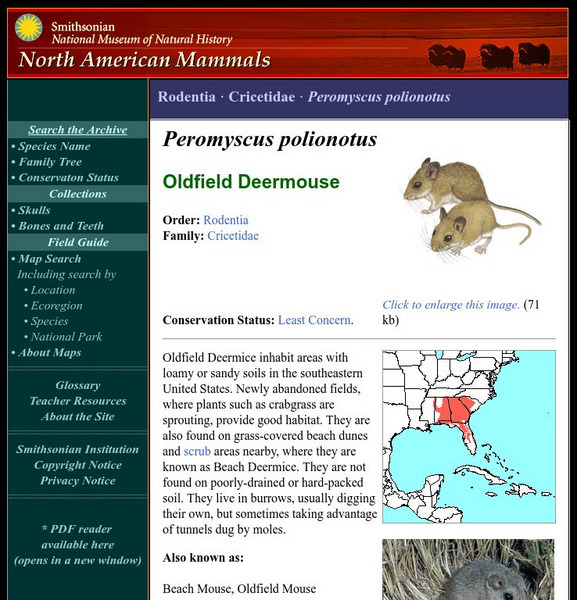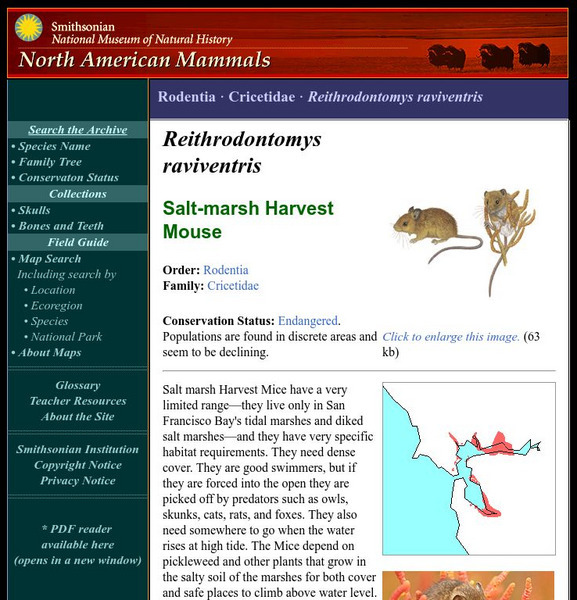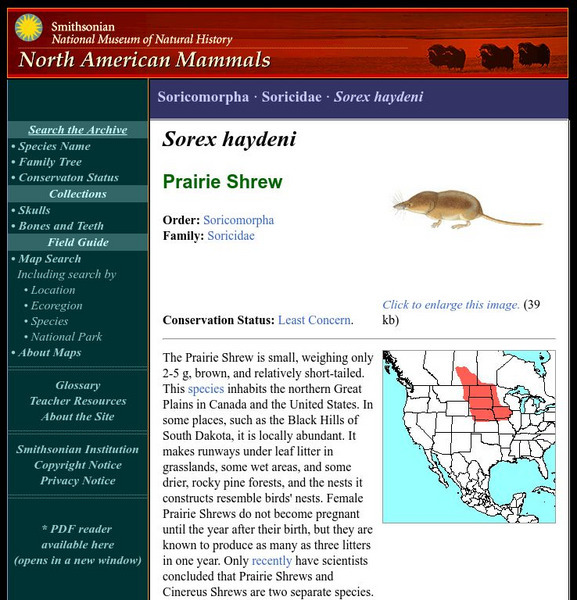Smithsonian Institution
National Museum of Natural History: American Mammals: White Ankled Mouse
The White-ankled Mouse is common in rocky areas in both dry and humid regions on the Central Plateau of Mexico and in west and central Texas, southern New Mexico, and Oklahoma. It clearly prefers rocky situations, whether it lives in...
Smithsonian Institution
National Museum of Natural History: American Mammals: Northern Rock Deermouse
Northern Rock Deermice live in rocky outcrops and among boulders in pinyon-juniper-oak woodlands in the foothills of mountains from Colorado and New Mexico south to Texas and northern Mexico. Populations of the Mice are separated from...
Smithsonian Institution
National Museum of Natural History: American Mammals: Mesquite Mouse
Mesquite Mice live in dense mesquite thickets known as bosques. Although mesquite is the dominant plant in bosques, other desert plants such as palo-verde, prickly pear, and cholla cacti, and grasses, mix with the mesquite. Learn more...
Smithsonian Institution
National Museum of Natural History: American Mammals: White Footed Mouse
The White-footed Mouse has a very wide distribution. It is the most abundant rodent in mixed deciduous and coniferous forests in the eastern United States, and is probably equally abundant near farms. Learn more about the Peromyscus...
Smithsonian Institution
National Museum of Natural History: American Mammals: Northwestern Deermouse
Keen's Deermouse is the most common deermouse in the Pacific Northwest. It inhabits rainy, mild climate zones at higher elevations than the closely-related Deermouse (Peromyscus maniculatus), and prefers areas where the forest canopy is...
Smithsonian Institution
National Museum of Natural History: American Mammals: Osgood's Mouse
Osgood's Mouse is a very close relative of the Pinyon Mouse but is larger, and its tail is longer than the head and body. Osgood's Mouse lives in the mountains of southern New Mexico and throughout mountainous central Mexico. Learn more...
Smithsonian Institution
National Museum of Natural History: American Mammals: Southwestern Myotis
Southwestern myotis live in a variety of southwestern mountain habitats, from desert grasslands up into pine and mixed coniferous forest in the United States, and in desert and grassland in Mexico. These bats and two other myotis...
Smithsonian Institution
National Museum of Natural History: American Mammals: Northern Long Eared Myotis
Although the northern long-eared myotis is common and widespread, much remains to be learned about its roosting habits, reproduction, and longevity. This bat is known to hibernate in caves and mines and to roost under tree bark. Learn...
Smithsonian Institution
National Museum of Natural History: American Mammals: Pocketed Free Tailed Bat
A small fold, or "pocket" in the wing membrane of the free-tailed bat, near its knee, gives this bat its common name. Pocketed free-tailed bats have large ears and long wings, and fly rapidly, generally pursuing insects on the wing....
Smithsonian Institution
National Museum of Natural History: American Mammals: Marsh Rice Rat
Marsh rice rats are among the most common mammals inhabiting tidal marshes of the Gulf and Atlantic coasts. Being good swimmers, diving to 10 m and crossing 300 m stretches of water, and able climbers, these rice rats are suitably...
Smithsonian Institution
National Museum of Natural History: American Mammals: Pinyon Deermouse
Pinyon Deermice reproduce from mid-February through mid-November, giving birth to litters of 3-6 blind, hairless young that weigh about 2.3 g each. Learn more about the Peromyscus truei, more commonly known as a Pinyon Mouse, in this...
Smithsonian Institution
National Museum of Natural History: American Mammals: Oldfield Mouse
Oldfield Mice inhabit areas with loamy or sandy soils in the southeastern United States. Newly abandoned fields, where plants such as crabgrass are sprouting, provide good habitat. Learn more about the Peromyscus polionotus, more...
Smithsonian Institution
National Museum of Natural History: American Mammals: Pygmy Rabbit
Pygmy Rabbits dig extensive burrow systems, which are also used by other animals. Loss of habitat is a direct threat to this species, which depends on big sagebrush, particularly mature stands of it. Learn more about the Brachylagus...
Smithsonian Institution
National Museum of Natural History: American Mammals: Plains Harvest Mouse
Plains Harvest Mice are found in grassy areas, including hay and wheat fields. They seem to prefer shorter grasses, and build round nests of grass on or near the ground. Learn more about the Reithrodontomys montanus, more commonly known...
Smithsonian Institution
National Museum of Natural History: American Mammals: Salt Marsh Harvest Mouse
Salt-marsh Harvest Mice have a very limited range, they live only in San Francisco Bay's tidal marshes and diked salt marshes and they have very specific habitat requirements. They need dense cover. Learn more about the Reithrodontomys...
Smithsonian Institution
National Museum of Natural History: American Mammals: Western Harvest Mouse
Western Harvest Mice are adaptable, widespread, and abundant, especially in meadows, prairies, old pastures, stream valleys, and marshes. They eat seeds, insects, and plants. Learn more about the Reithrodontomys megalotis, more commonly...
Smithsonian Institution
National Museum of Natural History: American Mammals: Townsend's Mole
The largest moles in North America, weighing in at 100 - 171 grams, Townsend's Moles live only in the lowlands on the western side of the Cascade Mountains, from northwestern California to extreme southwestern British Columbia. One...
Smithsonian Institution
National Museum of Natural History: American Mammals: Nelson's Antelope Squirrel
Open, rolling land and gentle slopes with shrubs are the habitat of Nelson's Antelope Squirrel, which lives only in a small region of California in and near the San Joaquin Valley. The squirrels live in relatively small colonies of six...
Smithsonian Institution
National Museum of Natural History: American Mammals: Mexican Fox Squirrel
Mexican Fox Squirrels are large but secretive, and though they spend much of their time on the ground, can be difficult to find at any season. They do not store food or bury nuts. Learn more about the Sciurus nayaritensis, more commonly...
Smithsonian Institution
National Museum of Natural History: American Mammals: Yellow Nosed Cotton Rat
Voles and cotton rats usually live in different geographic regions, but both groups of small rodents eat grass and make runways. Yellow-nosed Cotton Rats are especially vole-like because they are small and live in grassy patches of...
Smithsonian Institution
National Museum of Natural History: American Mammals: Tawny Bellied Cotton Rat
The tawny-bellied cotton rat is the largest of the Sigmodon species, and dominates other cotton rats where more than one species occurs. Its back fur has a speckled, "salt and pepper" look, and its underparts are buff-colored, giving it...
Smithsonian Institution
National Museum of Natural History: American Mammals: Prairie Shrew
The Prairie Shrew is small, weighing only 2-5 g, brown, and relatively short-tailed. This species inhabits the northern Great Plains in Canada and the United States. Learn more about the Sorex haydeni, more commonly known as a Prairie...
Smithsonian Institution
National Museum of Natural History: American Mammals: Smoky Shrew
Shrews of many kinds often live in size-ranked communities. Such a community might include large, medium, and small shrews such as the Short-tailed, Smoky, and Cinereus Shrews, which feed, respectively, on large, medium, and small...
Smithsonian Institution
National Museum of Natural History: American Mammals: Long Tailed Shrew
The Long-tailed Shrew probably uses its long tail for balance when it is climbing among the rocks or boulders that are always present where it lives. It spends almost all its time underground, and was, until recently, thought to be...























